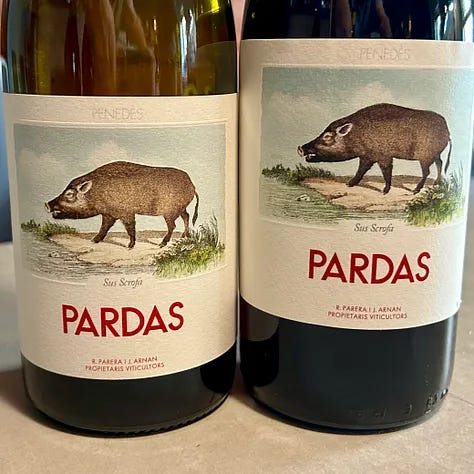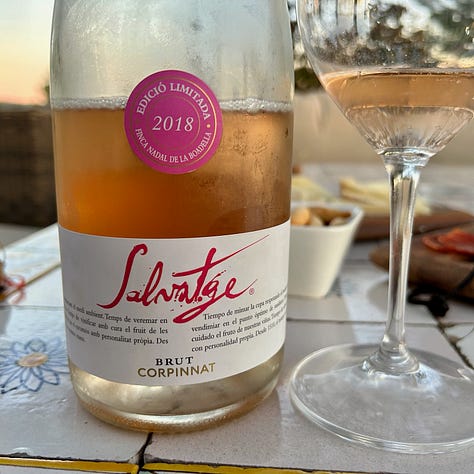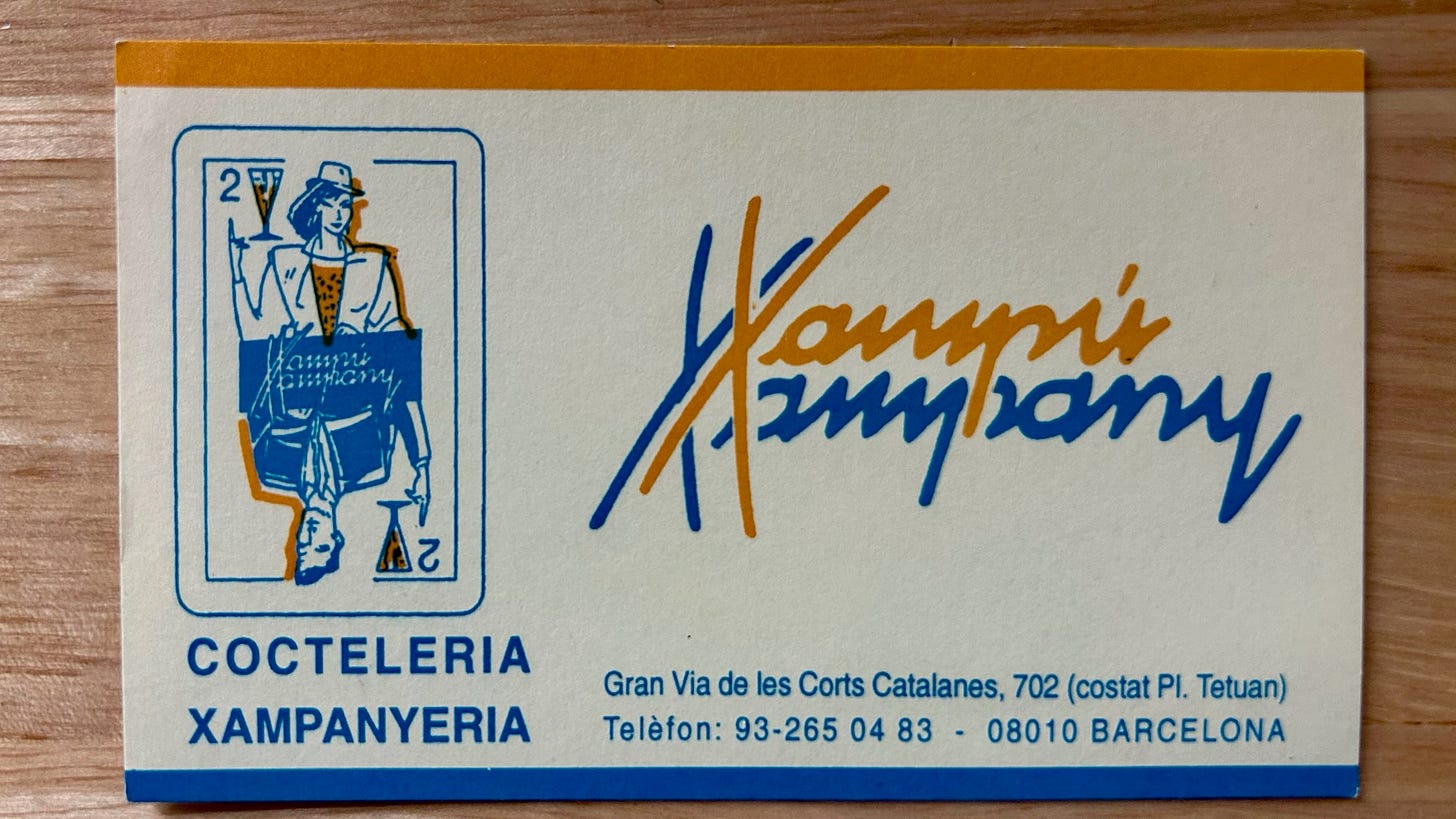Corpinnat is a Wine of Resistance
Why the best Catalan sparkling wine chooses not to be called "Cava" anymore. Including my bottle recommendations.
“I don’t understand the wine education on Spain. They’re teaching Spanish wine as if it were 25 years ago,” Ramon Parera of Celler Pardas said to me recently, as we walked through one of his vineyards, riddled by Catalonia’s four-year drought. “But the big traditional regions want it that way.”
Parera’s take is spot on. Consider the wines of his own area, Penedès. If you’ve experienced any wine education, you likely learned about Cava as Spain’s best-known sparkling wine. But Cava—like a lot of Spanish wine—is too often understood through the lens of other nations’ wines. At the top end, Cava is Spain’s answer to Champagne. Unfortunately, most people know it at the bottom end, as Spain’s answer to cheap Prosecco. Even within Spain, Cava is cheap, with 90 percent of it retailing for under 10 euros. To say that there is an ocean of middling Cava is an understatement.
The problem is that Cava, as it’s currently defined, is a wine without a true geographic identity. Though it’s protected as a Denominación de Origen (D.O.), Cava can be made in over 20 different regions across Spain, so long as it’s made méthode traditionnelle. More than 75 percent of Cava production is by two huge wineries, Freixenet and Codorníu, who control the D.O. and impose their will.
Faced with being under the thumb of Big Cava, a group of Penedès producers broke away from the D.O. in 2017, leaving to bottle their wines under the brand name Corpinnat (meaning “heart of Penedès” in Latin). Corpinnat follows much stricter rules for its grape growing and winemaking, and now includes many of the region’s top wineries: Recaredo, Gramona, Nadal, Llopart, Mas Candí, Celler Pardas, as well as up-and-coming producers such as Júlia Bernet and Cisteller. This month, Corpinnat added its 14th member.
I’ve talked about all this before. In fact, not too long ago I wrote a piece for Wine Enthusiast headlined “Why the Best Cava Isn’t Called ‘Cava’ Anymore,” that ruffled a few feathers.
Suffice to say that people with vested interests in Big Cava were not very happy with me. So what happens in the world of wine when large organizations ruled by corporate interests, with lots of money, don’t like the message of your article? Well, they contact your bosses at the magazine to demand fake “corrections.” They unlease the minions who take their money to nitpick you on social media. They also try to charm you, dispatching their public relations people to invite you, all expenses paid, to Spain for a grand tasting. (I’ve chronicled all this Cava drama, too.)
So to recap, the world of wine works just like the rest of our dismal late capitalist culture, with its enormous pressure to consume cheap, unsustainable things at the expense of quality, intentional, beautiful things. Which is why I admire the winemakers of Corpinnat who collectively said “enough!” and left Cava.
Lately, I’ve been writing about the idea of wine drinking as resistance. Corpinnat is a good example of what I’m talking about. Perhaps it’s not surprising, since Catalonia has long been a place of resistance. When you visit Nadal winery, for instance, you’re told the story of how founder Ramon Nadal Giró fled to Champagne during the Spanish Civil War when his estate was commandeered by the military for an airfield.
In the late 20th century, people in Catalonia referred to their local sparkling wine as xampany (the X is pronounced as if saying shah). When Spain was to join the European Union in the 1980s, France objected to the use of xampany for obvious reasons (sound it out). That’s when “Cava,” the Spanish word for cave or cellar, came into usage. But you can still find sparkling wine listed as xampany in some of Barcelona’s old wine bars.
Let’s also not forget how, in 2017, many Spaniards boycotted Cava when Catalonia’s separatist government held a referendum on independence.
Corpinnat was not even the first rebellion against Cava. In 2012, Pepe Raventós of the famed Raventós i Blanc estate left the D.O. to bottle under his own invented designation, Conca del Riu Anoia. The following year, a group of producers seceded to start a brand under D.O. Penedès, called Clàssic Penedès, which includes excellent wineries such as AT Roca, Colet, and Loxarel.
But Corpinnat has been bold in defining what quality wine—in opposition to cheap wine—should look like. Grapes must be organic and picked by hand. All wine must be made at the winery, with no juice bought from outside. If Corpinnat wineries buy grapes, they are obligated to pay a higher, premium price to growers. Aging rules are also strict: All Corpinnat wines must spend at least 18 months on the lees (meaning all wines qualify as Reserva) and wineries must make at least one wine that ages 30 months or more and another aged 60 months or more on the lees.
Last month, on the evening before Barcelona Wine Week, the Corpinnat organization hosted a wonderful tasting, with all of its producers pouring their 2024 base wines, as well as a recent release. The quality of sparkling wine in that room was off the charts. Some standouts for me included Júlia Bernet’s 2018 Barraca dels Coscons and the 2018 Vinya del Rascarà from Bufadors, a side project of Recaredo’s winemaker, Ton Mata (both frustratingly impossible to find in the U.S.) But the most noteworthy wine of the evening may have been Celler Pardas’ 2017 Els Pagesos made from the red sumoll grape.
I visited Pardas a few days later, near the village of Torrelavit about an hour from Barcelona, which is how I ended up walking around Ramon Parera’s drought-affected vineyards. “Lately, with the climate change,” he said, “the only grapes that are working are xarel·lo and sumoll.”
I’ve sung the praises of xarel·lo many times before. And I’ve fallen in love with sumoll in its still form—bright, fresh, delicate red wines if the grape grown and handled right. But sparkling sumoll is a different thing entirely. “It’s a crazy grape. Sumoll needs struggle. It needs poorer soils. It needs drought,” Parera told me. “Nobody loved sumoll until recently,”
Historically, sumoll was widely planted in Catalonia, but the grape was canceled by Big Cava. “In Cava you’re forbidden to use sumoll, but you can use it in Corpinnat,” Parera said.



Parera is a vinylhead with a huge record collection and amazing stereo in the tasting room. He put Alex Chilton’s Clichés on the turntable and opened the 2017 Els Pagesos. Chilton’s idiosyncratic, shambolic music was a good pairing with this sumoll sparkling wine—something completely unique, with notes of bitter melon, lavender, blood orange, yuzu, an underlying umami, briny quality on the palate, and a long, crisp finish. It was like tasting new knowledge.
We will still have to wait a bit before we see Els Pagesos in the U.S., but you can now find Mas Candí’s Indomable, a 50/50 blend of sumoll and xarel·lo that is another great example of things to come.
“In the next few years, there will be 40 sparkling sumoll,” declared Parera’s partner, Jordi Arnan. “Everyone calls me looking for sumoll to graft.”
It’s just another reason why Corpinnat is redefining Spanish sparkling wine. “People around the world were thinking cava was only a massive, cheap wine But we can compete with any sparkling wine in the world,” said Ton Mata of Recaredo. “Corpinnat wants to play in the Champions League. We have a wonderful story, and it’s a true story.”
Of course, my writing about this story will likely upset Big Cava and its minions again.
A Cache of Corpinnat



My bottle recommendations and tasting notes are for paid subscribers only. Click here for a special discount!





